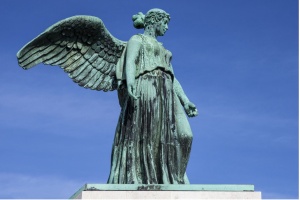Understanding the Statue of Peace
Standing proudly along the picturesque Langelinie promenade in Copenhagen, the Statue of Peace serves as a poignant reminder of the sacrifice made by Danish merchant sailors during World War I. This striking memorial is not only a tribute to the maritime heroes but also a testament to the enduring bond between Denmark and Italy, symbolized by its lavish Italian marble base.
Italian Craftsmanship and Danish Heritage
The Statue of Peace emerged from a national competition aimed at honoring the bravery of Danish sailors who faced perilous seas and wartime dangers. The distinguished sculptor Svend Rathsack, along with architect Ivar Bentsen, delivered a work of art that was unveiled in 1928, blending Danish maritime heritage with exquisite Italian artistry.
The Italian marble plinth, renowned for its remarkable quality and elegance, greatly enhances the monument’s aesthetic appeal. Far from being merely decorative, the marble signifies a connection between Denmark’s commemoration of its lost sailors and Italy’s long-standing tradition of craftsmanship in memorial art.
Features and Symbolism of the Statue
Intricate reliefs carved into the marble tell the stories of the 648 Danish merchant sailors who lost their lives at sea during the war. These visual narratives depict maritime life and the hazards that accompanied naval navigation, inviting onlookers to engage with the profound themes of sacrifice and courage. The union of Danish historical context and Italian artistic culture weaves a rich tapestry of shared values, memorializing the quest for peace.
Cultural Exchange and Impact
More than just a static monument, the Statue of Peace embodies international friendship and cultural exchange. It exemplifies how the collective aspiration for peace transcends geographical boundaries. Visitors to Langelinie encounter the statue from various angles, whether to pay their respects, learn about Danish maritime history, or simply admire its artistic integrity.
Educational trips often include the statue as part of the curriculum, highlighting its significance and fostering appreciation for the integration of Nordic history with Mediterranean artistry. The careful craftsmanship visible in the marble reliefs underscores the meticulous attention to detail, propelling the statue into a realm of international heritage.
A Historical Perspective on Maritime Memorials
The use of Italian marble in memorials has a long history, often associated with beauty, dignity, and reverence. This material has graced many significant statues from the Renaissance to modern times, serving as a vehicle for honoring those who have fallen. By selecting this particular stone, the Danish government and artists signaled their commitment to create a lasting tribute worthy of the sacrifices made by their sailors.
Historically, the relationship between Italy and Denmark is enriched by shared ideals of peace and human dignity. The Statue of Peace stands as a vital reminder of the costs of war and the importance of harmony between nations, resonating with visitors from various backgrounds who recognize the universal experience of loss and the shared hope for a peaceful future.
Experiencing the Statue of Peace Today
A visit to the Statue of Peace offers a moment of reflection against the backdrop of Copenhagen’s stunning waterfront. The serene expression of the statue and the resilience encapsulated within the marble encourage visitors to contemplate the bravery of those who navigated treacherous waters during global conflict.
The statue itself, weathered yet enduring, serves as a metaphor for peace—a hope that resonates with individuals from all walks of life. Visitors come equipped with cameras and a shared eagerness to connect with the statue on various levels—historical, artistic, and personal.
Cultural Significance of the Statue
The integration of Italian marble within this Danish tribute illustrates how cultural materials can enhance the storytelling of a nation’s legacy. It ails locals and tourists alike to recognize that memorializing the past is a communal endeavor strengthened through international cooperation. This cultural bridge established between Denmark’s maritime history and Italian artistry is an enduring symbol of mutual respect and collaboration.
The Broader Role of Maritime Memorials
The Statue of Peace transcends its local significance; it stands as a narrative of conflict, loss, and international camaraderie. As the world continues to grapple with the notion of peace, memorials like this serve as beacons of hope, inspiring dialogue and encouraging respect for those who made the ultimate sacrifice.
With an exquisite blend of Danish narrative and Italian sculpture, the statue engages visitors to confront historical realities while also nurturing a hope for future harmony.
Conclusion
The Statue of Peace symbolizes more than remembrance; it embodies a promise of unity that spans countries and cultures. By yielding a connection between Denmark and Italy through its exquisite marble and historical significance, it serves as a powerful reminder of the shared human experience of loss and the overarching desire for peace.
In regions rich with maritime history, such as Copenhagen, the beauty of the Statue of Peace resonates profoundly. For enthusiasts of yachting, boating, or planning a trip to coastlines dotted with memorials and breathtaking views, it’s a reminder that harmony and adventure can sail hand in hand. Explore more on GetBoat.com, your gateway to renting boats and sailing, where the waves meet the stories of the past.


